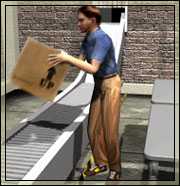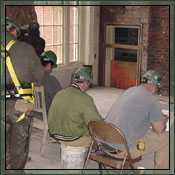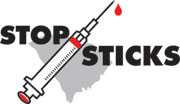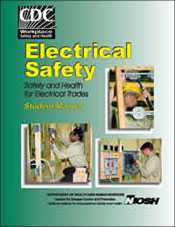TRAINING RESEARCH AND EVALUATION
On this Page
- Hearing Loss Intervention for Carpenters
- NIOSH Lifting Equation CD-ROM Training
- Evaluating Toolbox Training in Construction and Mining
- Core OSH Training for New/Young Workers
- HIV Information Dissemination Project
- Evaluation of Electrical Safety High School Curriculum
- Training for Wood Pallet Manufacturing Industry
- Computer mouse training for ESL workers

Selected Projects by Category
Field Studies/Assessments
- Hearing Loss Intervention for Carpenters
- Evaluation of Toolbox Training in Construction and Mining
- HIV Information Dissemination Project
- Core OSH Training for New/Young Workers
- Manufacturing Industry
Classroom Testing
Laboratory Testing
Hearing Loss Intervention for Carpenters
Project Summary
NIOSH developed a comprehensive hearing loss intervention program for carpenters that was designed to cultivate behaviors that will reduce their incidence of occupational hearing loss. Carpenters are known to develop occupational hearing loss early, becoming substantially impaired by middle age.
This project collected observational data to assess the Hearing Loss Prevention Program's (HLPP) effectiveness in promoting carpenters' work site hearing health behaviors. It expanded upon existing partnerships between NIOSH and labor-management organizations within the construction industry to field test and evaluate this program. Measures included factors related to the feasibility of program adoption as well as knowledge gained by participants, behavioral intentions of participants, and correlation with actual workplace behaviors. The results of this effectiveness research have contributed to a better understanding of the challenges involved in preventing noise-induced hearing loss among construction workers. The model approach utilized in this program may also be applicable to a wide range of occupationally noise-exposed workers.
- Stephenson, CM & Stephenson MR (2011). Hearing loss prevention for carpenters: Part 1 – Using health communication and health promotion models to develop training that works. Noise & health, March-April 2011 | Volume 13 | Issue 51, pp.113-121.
- Stephenson MR & Stephenson CM (2011). Hearing loss prevention for carpenters: Part 2 – Demonstration projects using individualized and group training. Noise & Health, March-April 2011, vol 13, issue 51, PP. 122-131.

Application of Health Communication Theories
Flash Version
(788 KB; Flash plug-in required)
Download
(PowerPoint file; 3.7 MB)
NIOSH presentation addressing occupational hearing loss and prevention. Presented on August 9, 2000, in Baltimore, MD, at the Third Annual Force Health Protection Conference.
Noise-Induced Hearing Loss in the Construction Industry
HTML Version
Flash Version
(644 KB; Flash plug-in required)
Download
(PowerPoint file; 7.1 MB)
NIOSH presentation addressing occupational hearing loss and prevention in the construction industry. Presented on March 15, 2001, in Washington, DC, at OSHA's Advisory Committee for Construction Safety and Health (ACCSH).

NIOSH Lifting Equation
Project Summary
Use of the NIOSH lifting equation (LE), when planning industrial processes or work involving manual lifting can contribute to lowered incidence of low back disorders. To achieve these results, however, the LE must be widely available to engineers, and safety and health (S&H) professionals in a format that is easy to use and training and guidance must be provided to these professionals to assure accurate use of the equation to design safe lifts.
This project developed and evaluated an electronic instructional program (CD-ROM) that teaches users how to apply the NIOSH LE to evaluate and design safe manual lifting procedures. The CD-ROM training program should be available by fall 2013.

The Effectiveness of a NIOSH Multimedia Training Program
View
summary Powerpoint presentation
Presented on October 2002, in Baltimore, MD, at Best Practices In Occupational Safety and Health, Education, Training and Communication Conference
OSH Small Business Resources
Project Summary
Through this project, NIOSH partnered with NFIB and the Ohio BWC to study ways to meet the health and safety informational needs of small business owners. This project : 1) identified and reviewed existing training materials and programs that might be helpful to small businesses; 2) prepared a set of informational materials targeted to small business owners in a variety of formats including posters, flyers, brochures, booklets, and videos; and, 3) evaluated the effectiveness of these materials in encouraging small business owners to make health and safety changes in their workplace. From this early work, NIOSH expanded its outreach efforts to small businesses.

Evaluating Toolbox Training in Construction and Mining
Project Summary
This project has helped fill gaps in current knowledge regarding the critical elements, formats and approaches of toolbox training sessions. "Toolbox" or "tailgate" training sessions are short (usually 10- to 15- minute, weekly) lessons conducted on-site prior to work shifts. They are a primary mode of worker occupational safety and health (OS&H) training employed in small construction companies.
- Link to mining toolbox talks
- Construction toolbox talks are under development in collaboration with construction sector partners.

Examining the Impact of Narrative Case Studies in Toolbox Talks for Building Construction -
Download Powerpoint
(1.54MB)
Poster - Impact of Case Studies in Toolbox Safety Talks
Download Powerpoint
(670 KB)
Presented on October 2002, in Baltimore, MD, at Best Practices In Occupational Safety and Health, Education, Training and Communication Conference
Core OSH Training for New
Young Workers
Project Summary
Through this project, NIOSH created a core curriculum in occupational safety and health focusing on the special needs of new and young workers. In partnership with the state directors of career and technical education, the curriculum was evaluated in schools and has been available to teachers and youth programs on the NIOSH website since 2007. Currently, the curriculum is being completely updated and revised into 45 minute modules in response to input from users, students, and teachers. The new version is expected to be available by fall 2013.

HIV Information Dissemination Demonstration Project
Project Summary
The purpose of this project was to develop and pilot a demonstration health communication intervention to: (1) raise the awareness of health care workers (clinical and non-clinical) and administrators about the recommendations in the NIOSH Needlestick Alert and future NIOSH publications; and (2) decrease occupational exposure to HIV-1 by increasing prevention behaviors among workers, and influencing administrator's policy-decisions and buying behaviors. During the project, multiple messages were delivered to the three target audiences: clinical health care workers, non-clinical workers, and health facility managers. Evaluation of communication effectiveness was a major component of the project. All materials developed through this project are available on the NIOSH website for health care facilities that may wish to conduct a "stop sticks" campaign.

Evaluation of Electrical Safety High School Curriculum
Project Summary
Pre-job training in occupational safety and health is one form of intervention that may reduce the disproportionately high rate of injuries occurring in new and young workers. The potential effectiveness of pre-job health and and safety training depends upon how effectively the curriculum is delivered to the students and integrated into their trade programs. Through this project, schools tested a prototype NIOSH electrical safety curriculum during the 1999-2000 school year. Students' knowledge gain, safe work attitudes and beliefs, and behavioral intentions on the job were assessed and compared to students who completed the current, generic electrical trades training program. Based on the study findings, the student manual was revised and published in 2002. The manual was updated in 2009 to correct minor errors in the document and to reflect changes in electrical codes.
DHHS (NIOSH) Publication No. 2002-123 (2002) has been superseded by
Publication Number 2009-113 .Development of Training for the Wood Pallet Manufacturing Industry
Project Summary
NIOSH researchers investigated occupational safety and health concerns in the small business wood pallet manufacturing industry. Pallet makers have an injury rate 226% greater than that for general industry. The study included walk-through evaluations at wood pallet manufacturing companies, environmental measurements, and the development of educational materials designed to meet the needs of owners and their workers. Measurements were taken of carbon monoxide (CO) levels, noise levels, ergonomic observations, and occupational safety practices. The materials developed for the study offer suggestions as to how these hazards might be ameliorated.
- Malkin R, Lentz TJ, Topmiller J, Hudock SD, Niemeier RW (2006). Characterization of airborne occupational safety and health hazards in selected small businesses: manufacturing wood pallets. Industrial Health, 44, 58-63.
- A set of web pages containing study findings and educational materials suitable for use by small pallet makers is under development, scheduled completion 2014.
Computer mouse use for ESL workers
Project Summary
Computer based training is common throughout all work sectors. Through this project, NIOSH developed a mouse tutorial that teaches users with limited or no computer skills, and with little or no English proficiency, how to scroll, click, and navigate a screen using a computer mouse. These skills are necessary for workers asked to take even a very simple computer based training program. The product was developed and tested in the laboratory, and underwent additional field testing with ESL immigrant workers. The product will be a stand-alone module that can be used with any computer based training program or before asking participants to complete computer based surveys.
- The training product should be available fall 2013
- Page last reviewed: December 30, 2013
- Page last updated: December 30, 2013
- Content source:
- National Institute for Occupational Safety and Health Education and Information Division


 ShareCompartir
ShareCompartir